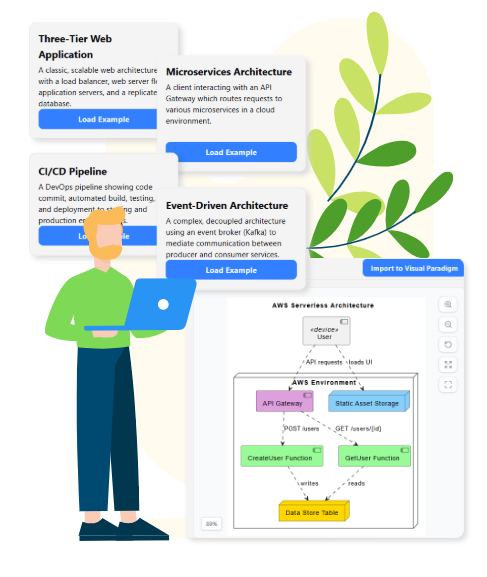Now Reading: Why Use a Deployment Diagram: Generator vs Manual PlantUML
-
01
Why Use a Deployment Diagram: Generator vs Manual PlantUML
Why Use a Deployment Diagram: Generator vs Manual PlantUML
Deployment diagrams are a critical part of software documentation. They show how components, servers, databases, and cloud services fit together in a system. While PlantUML offers a way to write these diagrams in plain text, doing so manually can be time-consuming and error-prone. A deployment diagram generator provides a faster, more accurate alternative that makes diagramming accessible to everyone on the team.
Manual PlantUML: Power with Limitations
- Flexibility comes at a cost -writing raw PlantUML requires memorizing syntax, rules, and element types.
- Common mistakes – duplicated aliases, wrong connectors, or missing brackets can break a diagram.
- Steep learning curve – new team members often struggle to produce valid PlantUML quickly.
- Context switching – switching between code and rendered diagram slows productivity.
How a Deployment Diagram Generator Helps

1. Time Savings
- Wizard-style forms eliminate the need to recall syntax.
- Add entities, containers, and relationships with dropdowns instead of typing code.
- Prebuilt examples (e.g., “three-tier web app”) give you a starting point instead of a blank screen.
2. Reduced Errors
- Intelligent validation prevents duplicate aliases and enforces PlantUML rules.
- The code is auto-generated, ensuring valid syntax every time.
- Real-time preview lets you catch and fix issues immediately.
3. Better Collaboration
- Diagrams can be saved as JSON files and shared.
- Teams can review architecture visually instead of interpreting raw PlantUML text.
- Version-controlled JSON files make architecture “code-like,” fitting into DevOps workflows.
Real-World Scenarios
System Architect
Creates a base diagram for a cloud platform and shares the JSON with developers.
DevOps Engineer
Builds a CI/CD pipeline diagram in minutes, avoiding syntax errors that slow manual edits.
Educator
Uses the tool to teach deployment concepts visually without overwhelming students with PlantUML syntax.
When Manual Coding Still Makes Sense
- Quick edits for small diagrams if you already know the syntax.
- Highly customized diagrams requiring advanced PlantUML features.
- Scripting diagrams as part of automated documentation pipelines.
Conclusion
Writing PlantUML manually offers flexibility, but for most scenarios, a deployment diagram generator is the smarter choice. It speeds up diagramming, reduces errors, and improves collaboration across teams. Whether you are documenting cloud infrastructure, explaining a microservices architecture, or teaching software design, the generator lets you focus on communication rather than code.

